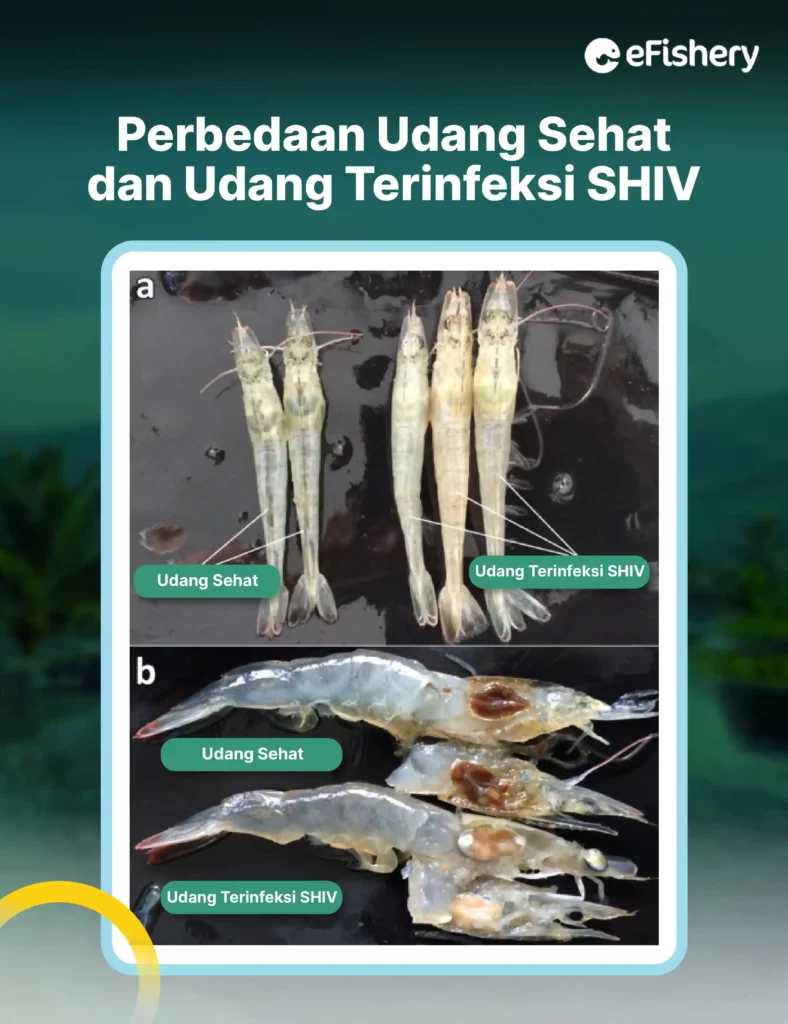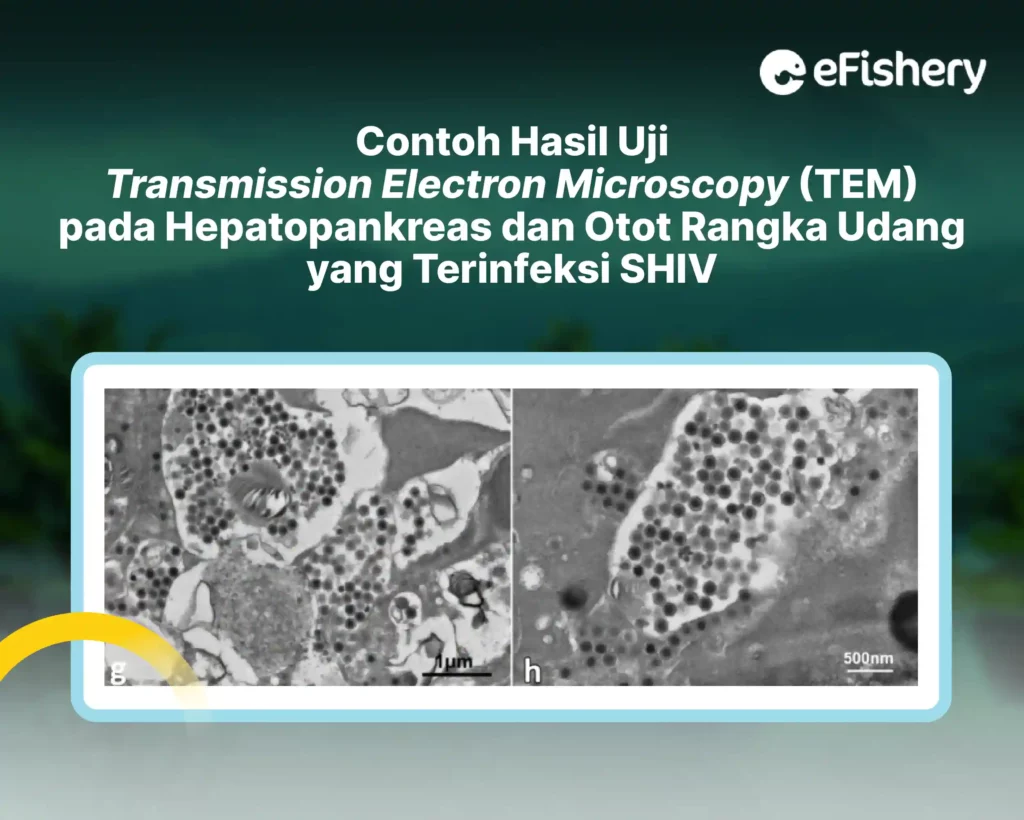The SHIV virus in shrimp is a new virus that can infect vannamei shrimp. Even though it's not as lively as other shrimp diseases, you still have to be aware of this one virus! Check out the explanation here to recognize the characteristics of shrimp infected with SHIV and how to handle them!
What is SHIV Disease?
SHIV or Shrimp Haemocyte Iridescent Virus is an infectious disease caused by a new virus from the family Iridoviridae and subfamily Betairidovirinae. This virus has a structure icosahedral with an average diameter of about 150 nanometers. This disease was first discovered in Zhejiang Province, China (China) in 2014, then was reported to infect several shrimp ponds in Thailand.
When Do Shrimp Get SHIV?
SHIV can infect all stages of cultured shrimp, from post larvae, juveniles to adult shrimp. Shrimp organs or tissues that can be infected by SHIV are hematopoietic tissue, hepatopancreas, pereiopods, uropods, pleopods, muscles, and haemocytes in tissues/organs such as gills.
SHIV disease infection is caused by drastic temperature changes as in outbreak season (generally after November when the water temperature is below 22 degrees celsius) or in conditions of increased water temperature due to too hot sunlight, which will usually cause an increase in infection in shrimp. In addition, another cause of SHIV disease is a decrease in water quality which usually occurs at the end of the rearing period. Decline in water quality, such as poor sediment quality and high levels of ammonia, nitrogen and nitrite can cause viruses to become active and shrimp to become stressed, making them susceptible to disease.
Apart from water quality, there are two types of transmission of SHIV disease, namely horizontal and vertical transmission. With horizontal transmission, SHIV disease spreads or is transmitted from one animal to another through direct contact or media such as water, inanimate objects, infected faeces, and others. Whereas vertical transmission means that SHIV disease is spread or transmitted through cannibalism of infected shrimp and broodstock.
SHIV Symptoms in Shrimp
SHIV-infected shrimp show clear clinical signs that can be observed with the naked eye, such as:
- Empty stomach and intestines
- Atrophy (shrinkage) of the hepatopancreas which is yellowish white
- Soft prawn shell
- Slightly reddish body in a third of the shrimp's body
- Shrimp antenna truncated
- Shrimp movement is weak
- The shrimp almost died, lost their ability to swim, and sank to the bottom of the pond
- The shrimp's appetite decreases or the shrimp stops eating
- Pale body color
- Black spots appear at the junction of the abdomen and pleopods when the shrimp dies

The picture above is an example of shrimp infected with SHIV. Figure a shows the differences in the bodies of healthy and SHIV-infected shrimp. SHIV-infected shrimp gut looks empty and the body is pale in color compared to normal shrimp or control shrimp which looks to have full gut and bright green body.
Figure b shows the difference in color of the heads of normal prawns and SHIV infected prawns. In shrimp infected with SHIV, the hepatopancreas is yellowish white in color compared to normal shrimp hepatopancreas which is brownish yellow.
How to Diagnose SHIV in Shrimp
SHIV-infected shrimp can be diagnosed directly by looking at clinical symptoms in shrimp such as body condition, shrimp movement, and others. To ensure that shrimp are infected with SHIV, you can do laboratory tests using the PCR or RT-PCR method.
The following is an example of the test results using Transmission electron microscopy (TEM) in the hepatopancreas and skeletal muscle of SHIV-infected shrimp. It can be seen that the SHIV virus is in the form of spots that gather in the shrimp tissue.

The Impact of SHIV on Shrimp
SHIV disease infection can cause significant economic losses for the shrimp aquaculture industry. In addition to reducing the quality of shrimp, the SHIV virus in shrimp can cause death of shrimp up to more than 80%.
How to Handling SHIV
If the shrimp show symptoms of SHIV, they can be immediately destroyed. However, if SHIV has infected all the shrimp in the pond, you must immediately harvest early. The goal is that the SHIV virus does not spread to other ponds or ponds.
Preventive measures that can be taken to avoid SHIV disease are:
- Screening or screening imported vannamei shrimp.
- Screening or screening cultivation inputs that have the potential to carry viruses such as seeds and live feed.
- Make sure the shrimp seeds are certified free of pathogens or specific pathogen free (SPF).
- tighten up biosecurity pond.
- Keep pond conditions sterile from pests that have the potential to carry (carrier) disease.
- Strengthen the shrimp immune system by providing nutritious feed, vitamins, minerals and immunostimulants.
- Implement shrimp health management.
Konsultasikan Cara Menangani SHIV melalui Konsultasi Budidaya eFarm
Need Help Regarding Shrimp Cultivation Business?
Fill in your personal data in the following form. Our team will immediately contact you via the number cellphone attached. Make sure the data entered is correct.
Prevention of SHIV is a way that you can do to avoid this disease. However, you must pay attention to the condition of the shrimp, such as habits or behavior, body condition, and shrimp appetite.
If you find things that are different from usual, you can directly consult shrimp farming issues through features Cultivation Consultation in app eFarm.
eFarm is an application that provides various features as a solution to cultivation problems. One of them is features Cultivation Consultation. This feature helps you get information on the right cultivation steps directly from eFishery shrimp farming experts. This feature is free and accessible 24 hours a day!
Consultation on shrimp farming is easier through the application eFarm. Come on downloads Now!
Questions Regarding SHIV Virus in Shrimp
SHIV or Shrimp Haemocyte Iridescent Virus is an infectious disease caused by a new virus from the family Iridoviridae and subfamily Betairidovirinae. This virus has a structure icosahedral with an average diameter of about 150 nanometers. SHIV can infect all stages of cultured shrimp, from post larvae, juveniles to adult shrimp. Shrimp organs or tissues that can be infected by SHIV are hematopoietic tissue, hepatopancreas, pereiopods, uropods, pleopods, muscles, and haemocytes in tissues/organs such as gills.
SHIV disease infection is caused by drastic temperature changes In addition, another cause of SHIV disease is a decrease in water quality which usually occurs at the end of the rearing period.
- Grobest. 2020. Shrimp Hemocyte Iridescent Virus – Causes and Prevention Methods. Accessed on 05 April 2023
- Liang, Q., M. Chen, X. Wan, C. Li, Q. Zhang, R. Wang, D. Cheng, X. Dong, B. Yang, X. Wang, J. Xiang and J. Huang. 2017. Characterization of a new member of Iridoviridae, Shrimp hemocyte iridescent virus (SHIV), found in white leg shrimp (Litopenaeus vannamei). NatureResearch. 7
- Waikhom Waikhom, D., S. Ngasotter and LS Devi. 2021. Shrimp Hemocyte Iridescent Virus (SHIV): An Emerging Shrimp Pathogen. Chronicle of Bioresource Management 5(2), 045-047
